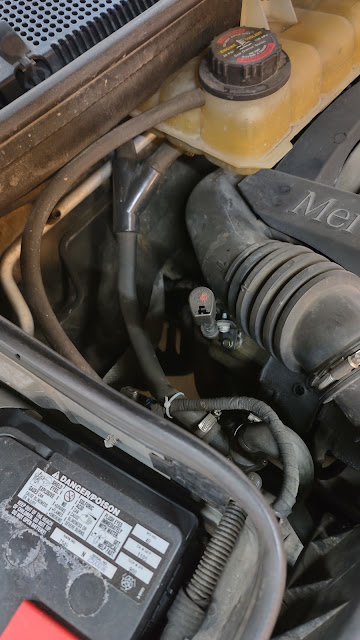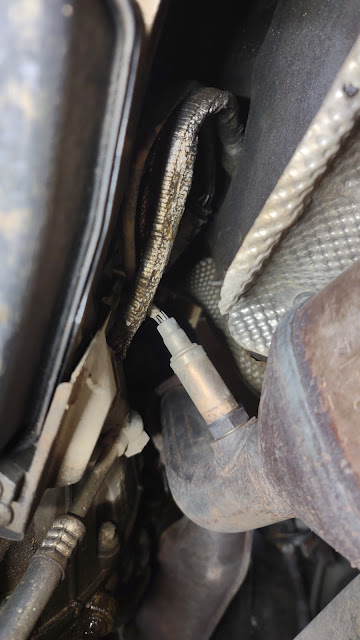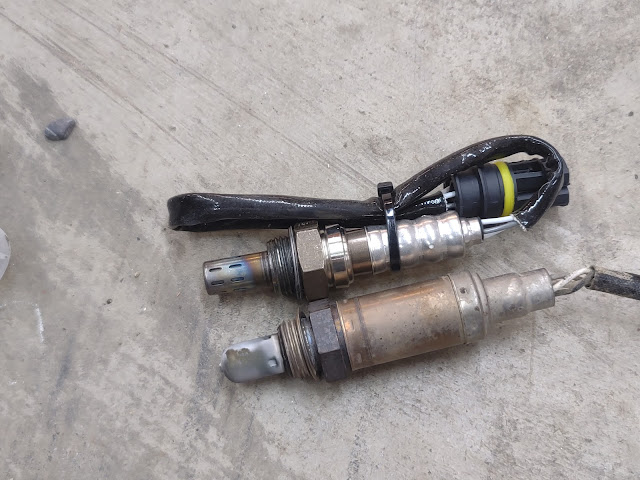"The key is to keep company only with people who uplift you, whose presence calls forth your best." - Epictetus
The wife's car (A Dodge Journey R/T POS) has been in lay-up over most of the winter. There is an intermittent electrical issue that causes the dash lights, radio, and blower motor for the heater to all shut down. After a moment, they will resume. I have been unable to locate the source of the problem, so the dealer will get a shot at troubleshooting and repairing this problem soon.
Meanwhile she has been driving our daughter's car, an older Mercedes-Benz ML320 sport utility vehicle, which has had its own minor issues. A little while back, the Anti-Lock Brake (ABS) system threw a code, and I had to replace a wheel speed sensor.
This time I received the complaint that the Check Engine Light had come on, and "should we even drive the car????" As far as I'm concerned, if the engine still runs, go ahead and drive it. It's probably just emissions stuff anyway. Nevertheless, I checked the code, and sure enough it was emissions-related. So I ordered the part from Amazon, and when I finally was able to get half a day in the shop - after church - replaced it.
Here's what the code reader said, once I got it connected. The connector for the analyzer is usually under the dash beneath the steering column.
The key line here is "DTCs in this ECU - 3". Translating from auto mechanic to English, it's telling us there are Three Diagnostic Trouble Codes in this vehicle's Engine Control Unit.
So on this analyzer, you push the little button with the square at the right, and it moves to this page below, telling us that one of the oxygen sensors in the exhaust system is not working correctly:
Cool, we can fix that! It's just a $20 part from Amazon. Problem is, this car has four of them! Which one is it???
Brief aside: The purpose of these sensors is to monitor oxygen in the left and right exhaust, upstream and downstream of each catalytic converter. The Engine Control Unit will trim the fuel flow to each side of the V6 engine once it is up to operating temperature to minimize emissions. When a sensor fails, the engine will tend to run rich, wasting fuel and eventually fouling the catalytic converter with unburnt carbon.
First I had to figure out which oxygen sensor required replacement, so amen for the internet! I found this image of a ML320 with the engine removed, and helpful pointers to each sensor.
Then I verified it with a second source, just to be sure the information was consistent.
Once I was certain that I had the right sensor, I took a look. I had been hopeful that I wouldn't have to get under the car, but a quick look sunk that hope. Below, view down to the sensor from the engine bay. Can you see it?
So I lifted the car and got on the creeper, after sopping up all the water that melted off the tires. A few turns with a 22 millimeter wrench, and out she came.
They were not identical at all, but the threads were the same, and so were the electrical connectors.
It went in fine, although making the electrical connection was difficult. There is a fat yellow O-ring to keep moisture out of the connection, and it wanted to roll instead of slide inside the connector.
Afterwards, I cleared the codes using the analyzer. I haven't yet taken it out on the road and warmed up the engine enough for that part of the emissions system to take over the fuel mixture. We shall see.










No comments:
Post a Comment